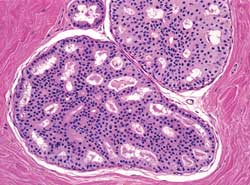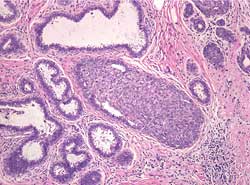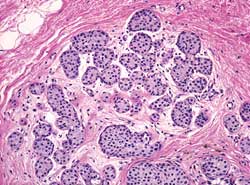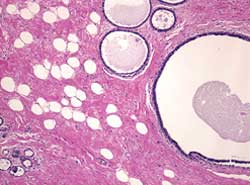Some benign breast disease may signal increased risk of breast cancer
The risk of cancer grew 4.2 times among women with atypical lesions; nonproliferative lesions did not increase risk.
Women with benign breast disease have an increased risk for breast cancer, according to a Mayo Clinic Cancer Center study. In addition, certain types of breast disease may predict the near-term development of breast cancer.
“Our findings indicate a link between select types of benign breast lesions and the later development of breast cancer,” said Lynn C. Hartmann, MD, a professor of oncology at the Mayo Clinic College of Medicine in Rochester, Minn. “Women who have a breast biopsy that is benign must discuss the possibility of additional risks with their doctors,” she said in a press release.
Atypical lesions, a strong family history of disease and earlier age at benign breast disease diagnosis were factors associated with an increased risk of breast cancer, she said.
It remains unclear which of the benign entities are actual precursors for breast cancer and which reflect a background of increased risk involving all breast tissue in a patient, she added.
Classifying lesions
She and her colleagues identified 9,087 women from the Mayo Clinic Surgical and Pathology Indices. The patients were between the ages of 18 and 85. Between January 1967 and December 1991, they had a biopsy of a benign breast lesion. The researchers administered questionnaires to obtain family history information and other possible risk factors for breast cancer.
|
|
|
|
Source: Daniel Visscher, MD | |
A breast pathologist, who was unaware of the initial diagnoses or patient outcomes, evaluated the benign breast samples. The pathologist then assigned each lesion as nonproliferative, proliferative or atypical.
The researchers referred to the Surveillance, Epidemiology and End Results (SEER) database for comparative information.
The researchers followed patients for a median of 15 years to determine any subsequent occurrences of breast cancer. Over the follow-up period, 707 of the women developed breast cancer. The median time from the original biopsy to breast cancer diagnosis was 10.7 years.
The age at diagnosis of benign breast disease and a family history of breast cancer were factors associated with the development of breast cancer, the researchers said. Patients who developed benign breast disease before the age of 40 increased their risk of cancer by 83%. Having a strong family history of breast cancer was associated with a 93% increase in risk.
Hartmann and her colleagues were encouraged to find convincing evidence that women with the most common, nonproliferative lesions had no increased risk of developing breast cancer, given they did not have a strong family history of the disease.
For proliferative and atypical types, however, the opposite was true. These lesions pointed to an increased risk of future breast cancer, even when the family history of breast cancer was negative.
The risk of cancer in patients with proliferative disease increased by 88%. Patients with atypical hyperplasia were 4.2 times more likely to develop breast cancer, compared with the SEER data.
For more information:
- Hartmann LC, Sellers TA, Frost MH, et al. Benign breast disease and the risk of breast cancer. N Engl J Med. 2005;353:229-237.




